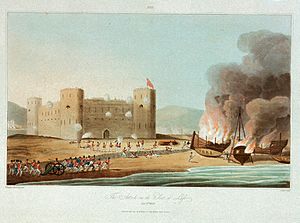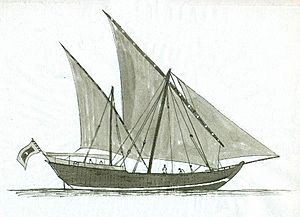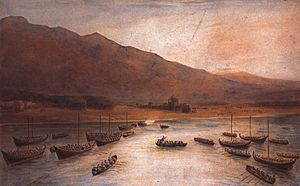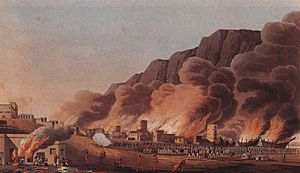Persian Gulf campaign of 1809 facts for kids
Quick facts for kids Persian Gulf campaign of 1809 |
|||||||
|---|---|---|---|---|---|---|---|
| Part of Piracy in the Persian Gulf | |||||||
 The fort of Luft under attack by the British, 27 December 1809 |
|||||||
|
|||||||
| Belligerents | |||||||
|
|||||||
| Commanders and leaders | |||||||
| Strength | |||||||
| Casualties and losses | |||||||
| Ras Al Khaimah: 5 killed 34 wounded Further operations: 70 killed and wounded Heavy casualties |
Ras Al Khaimah: Unknown 50 vessels burned Further operations: 50 killed 31 vessels burned |
||||||
|
|
|||||||
The Persian Gulf campaign of 1809 was a military operation by the British East India Company and the Royal Navy. Their goal was to stop the Al Qasimi people from attacking British ships in the Persian Gulf. These attacks were especially common near the Strait of Hormuz.
The operation had some success. It destroyed three Al Qasimi bases and over 80 ships. This included their biggest ship, the Minerva. However, the British Royal Navy was very busy with the Napoleonic Wars in Europe. This meant they couldn't completely stop the strong fleets of the Al Qasimi from Ras Al Khaimah and Sharjah. Even though the British continued their efforts into 1810, they couldn't destroy every Al Qasimi ship. By 1811, the attacks started again, but they were not as strong as before.
This operation was a joint effort between the Royal Navy and the East India Company's navy, called the Honourable East India Company (HEIC). Soldiers from the British base in Bombay also joined. Captain John Wainwright led the expedition. He sailed in the Navy ship HMS Chiffonne. The British sent this force because attacks on their ships in the Persian Gulf had increased. This happened after France set up diplomatic offices in Muscat and Tehran in 1807. These attacks not only hurt British trade but also put their relationships with Oman and Persia at risk. At the time, Britain was worried about France's plans against British India.
At that time, maps of the Persian Gulf were not very good. This allowed Al Qasimi ships to hide in unknown bays and inlets. Captain Wainwright reported this problem when he returned. This led to better British maps of the area.
Contents
Why the British Acted
In the early 1800s, the Indian Ocean was a very important part of the trade routes from British India to the United Kingdom. Large merchant ships, called "East Indiamen," regularly carried goods worth millions of pounds. One of the most important ports for Indian trade was Bombay. It was a major center for trade with ports in Persia and Arabia in the Persian Gulf.
Ships that traded in the Persian Gulf were called "country ships." They were much smaller and weaker than the big East Indiamen. Britain had always kept a navy presence in the area. But when the Napoleonic Wars started in 1803, many British ships were sent to fight in other parts of the world. This left the Persian Gulf and Arabian Sea mostly unprotected. Also, warships were needed to protect the East Indiamen from enemy ships. So, the Royal Navy ships in the Gulf were replaced by ships from the "Bombay Marine." This was the East India Company's own navy.
The Bombay Marine's ships were spread out over thousands of miles of ocean. This often left the country ships in the Persian Gulf unprotected. Since French raiders were rare in the Gulf, few country ships traveled in groups (convoys). This made them easy targets for pirate ships, called dhows and bhagalas. These pirate ships came from independent harbors in Persia or along the Arabian Peninsula.
In 1805, the Al Qasimi fleets captured two large ships, the Shannon and the Trimmer. The small Al Qasimi boats surrounded the bigger merchant ships and killed their crews. The Al Qasimi turned Trimmer into a powerful pirate ship. A few months later, the warship HCS Mornington, which had 24 guns, tried to get Trimmer back. But nearly 40 Al Qasimi ships attacked Mornington, and it barely escaped being destroyed itself.
Failed Peace Talks
The British didn't have enough naval forces to start a big military campaign in the Gulf. So, they tried to use diplomacy to end the pirate threat. In February 1806, the young Sultan of Oman, Sa'id II ibn Sultan, signed a treaty. He promised to stop attacks coming from his territory. But by 1807, the French had set up offices in Tehran and Muscat. With French encouragement, the attacks continued.
In 1807, Lord Minto, who was the Governor General of India, decided to send ambassadors. These ambassadors went to the Sikh Empire, Afghanistan, and Persia. The goal was to get their support and stop France from gaining allies near India's western borders. As part of this plan, the ambassador to Persia was told to talk about the pirate problem with the Persian government. But because of French influence in Tehran, he couldn't get any promises.
A second diplomatic mission was sent from London in 1808. It was led by Sir Harford Jones. Jones was also told to discuss the issue. He decided to travel to Bushire in Persia by sea. His group included the ship HMS Nereide and two smaller ships, HCS Sylph and HMS Sapphire. Captain Robert Corbet commanded the group. Once they reached the Persian Gulf, Corbet refused to wait for the slower ships. Nereide arrived at Bushire on October 14, 1808. Jones finished his trip by land.
Corbet sailed south to the Straits of Hormuz, expecting to meet the smaller ships on his way back. But on October 21, he found Sylph in the hands of the Al Qasimi. They had surrounded the isolated warship, captured it, and killed its crew. Corbet was able to get Sylph back. He later met up with Sapphire, which had been mapping the Persian coast. This event showed that the pirates now controlled the southern Persian Gulf.
Al Qasimi in the Arabian Sea
In April 1808, Al Qasimi dhows appeared off Gujarat, India. They raided ships at Surat. This happened even though the large warship HMS Albion and other ships had been briefly sent to the Persian Gulf. The Bombay Marine ships eventually drove them away. Later that year, a huge fleet of 50 pirate ships appeared off Sind in the Arabian Sea. They caused big problems for local trade. The fleet attacked merchant ships along the Indian coast. They even seized a large country ship called Minerva. They killed its crew and turned it into their main ship.
At its peak in early 1809, it was thought that the Al Qasimi forces in the Persian Gulf and Arabian Sea had 60 large bhagalas and over 800 dhows. They had 19,000 men. The British East India Company had only two ships, Mornington and Teignmouth, to fight them.
British Military Actions
After the raid on Sind and the 1809 monsoon season, the British in India decided to show their strength against the Al Qasimi. They wanted to destroy the pirate bases and ships. They also wanted to counter the French, who were encouraging the pirates from their embassies.
During the summer, forces gathered at Bombay. These included small East India Company warships like Mornington, Aurora, Ternate, Mercury, Nautilus, Prince of Wales, Ariel, Fury, and the bomb ketch Strombolo. Also, the Royal Navy ships Caroline (under Charles Gordon) and Chiffonne (under John Wainwright) joined. Wainwright was put in charge of the whole expedition.
Soldiers from the Bombay base also joined. These included a battalion of the 65th Foot, soldiers from the 47th Foot, and various East India Company marines, engineers, artillery men, and sepoys from the 2nd Bombay Native Infantry. Lieutenant Colonel Lionel Smith commanded these troops.
The expedition left Bombay on September 17. They planned to meet in Muscat the next week. However, they were delayed several times. First, they had to protect groups of country ships in the Arabian Sea. Then, they had to rescue survivors from the Stromboli. This ship was so old and weak that it broke apart in the ocean, and many lives were lost.
When the force finally arrived in Muscat in October, Sultan Sa'id told Wainwright that over 20,000 Bedouin warriors had come to the coast to join the Al Qasimi. Wainwright realized that a long land battle would be impossible with his forces. So, he decided to make a series of small raids against the main pirate bases near the Straits of Hormuz. He started with Ras Al Khaimah, on the Arabian coast north of the Strait.
Battle of Ras al-Khaimah
The British ships arrived off the town of Ras Al Khaimah on November 11. They found the Minerva and many dhows in the harbor. The pirate fleet first sailed out to attack the British. But they turned back when they saw how big the British force was. The Minerva couldn't get back into port successfully and got stuck on a sandbank. Its crew set the ship on fire to stop the British from capturing it.
On land, the Al Qasimi and their Bedouin allies (whose numbers were much less than 20,000) had set up defenses around the town. These defenses were protected from British ship attacks by sandbanks that blocked the bigger warships. On November 12, Wainwright sent his smaller ships closer to shore. They fired cannons at the town and protected his troops as they got ready to land.
At 2:00 AM on November 13, two groups of ship's boats landed on the beach. A small force led by Lieutenant Samuel Leslie landed north of the defenses. This was a diversion to distract the enemy. The main force, led by Lieutenant Colonel Smith, landed to the south. Leslie's diversion worked, but enough Arab defenders remained in the south to launch a strong counterattack on Smith's landing spot. Cannon fire from the ships covering the landing pushed the Arabs back. Smith ordered his men to advance with their bayonets. They pushed into the town, fighting the Arabs house by house. To help their advance, Smith's men set fire to buildings in their path. This created a lot of smoke. Under the cover of this smoke, Smith was able to attack and capture the Sheik's palace.
With the harbor now safe, Wainwright ordered his ships into the bay. There, they burned over 50 Al Qasimi ships, including 30 large bhagalas. Smith secured the town itself. His men burned warehouses and destroyed ammunition and defenses around the town. The Arab forces, who had retreated after the palace fell, taunted the British from the nearby hills. But they did not attack again. By the morning of November 14, the operation was finished. The British force returned to their ships. They had lost five men killed and 34 wounded. Arab losses are unknown but were likely high. The damage to the Al Qasimi fleets was severe. More than half of their largest and most dangerous ships had been destroyed at Ras Al Khaimah.
More Operations
On November 17, Wainwright ordered an attack on the Persian town of Linga. The people there fled when the British fleet arrived. Wainwright's ships burned 20 dhows without any fighting or British casualties. Further searches along the Southern Persian coast showed that most harbors were empty.
Wainwright's main target was Laft on Qeshm Island. This was a major Al Qasimi stronghold. He sent ships to block the channels leading to Qeshm. Wainwright then hired local pilots and attacked the town on November 26. After talks with local leaders failed, Wainwright ordered an attack on November 27 at 2:00 PM. Smith's troops landed without any resistance. Thinking the enemy had fled, Smith's men approached the town's fort. But heavy fire was unleashed on them as the British troops reached the gate.
Despite many casualties, Smith was able to rally his forces. With cannon support from the ship Fury, they forced the fort to surrender at sunset. The local leader was promised he would not be harmed or taken prisoner. British landing parties burned 11 large Arab ships. The British force had 70 casualties in the fight at the fort. Arab losses were estimated at more than 50 killed in the fort alone.
The town was given to Sheik Dewar, a local ruler who supported the British. Wainwright pulled his forces back to Muscat in early December. All the ships met there by Christmas. Only one more operation was launched. On January 3, 1810, they successfully attacked the town of Shinas. This town had rebelled against Sultan Sa'id. It was quickly recaptured and returned to him.
Even though minor naval operations against individual local ships continued into 1810, Wainwright and most of his ships returned to Bombay in January. They felt their mission to seriously damage the Al Qasimi forces in the Persian Gulf had been a success.
What Happened Next
The operation succeeded in reducing French influence in Oman. It also discouraged local leaders from encouraging attacks on British shipping. However, it couldn't completely stop Al Qasimi activity in the Persian Gulf. By 1811, many Royal Navy and East India Company forces in the Indian Ocean were sent to Java. The Al Qasimi returned in force, but their destructive actions were weaker than before. They rarely went into the Arabian Sea.
It wasn't until the forces of the Ottoman Empire captured Medina in 1812 that some control could be put on the tribes of the Arabian peninsula. Later British actions, both military and diplomatic, also reduced the threat of attacks during the 1800s.
The campaign also had a big effect on British map-making in the region. Wainwright reported that the maps of the Persian Gulf were not accurate or complete. This allowed Al Qasimi ships to hide in unknown inlets. The Bombay Marine had known about this problem for years. They had been making maps of the region under David Ewen Bartholomew. He had been on the Sapphire during Corbet's mission. His improved maps were published in 1810 because of these problems.
Images for kids





